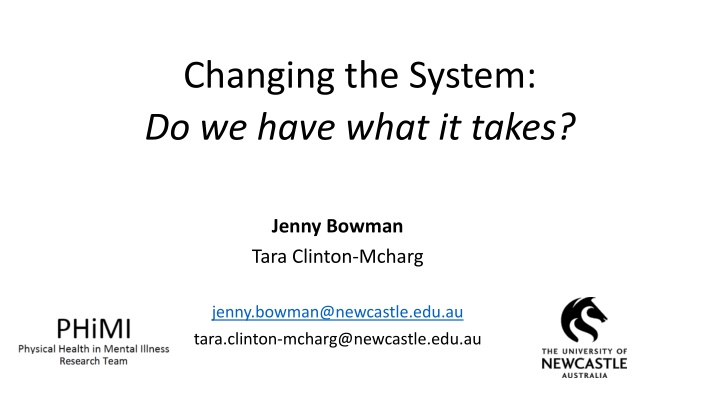Changing the System: Do We Have What It Takes?
This content explores the concept of a complex system, the importance of systems thinking, and how systems change happens. It delves into the factors that make a system more than the sum of its parts, the challenges in addressing wicked problems, and the framework for engaging with systems change effectively.
Download Presentation

Please find below an Image/Link to download the presentation.
The content on the website is provided AS IS for your information and personal use only. It may not be sold, licensed, or shared on other websites without obtaining consent from the author.If you encounter any issues during the download, it is possible that the publisher has removed the file from their server.
You are allowed to download the files provided on this website for personal or commercial use, subject to the condition that they are used lawfully. All files are the property of their respective owners.
The content on the website is provided AS IS for your information and personal use only. It may not be sold, licensed, or shared on other websites without obtaining consent from the author.
E N D
Presentation Transcript
Changing the System: Do we have what it takes? Jenny Bowman Tara Clinton-Mcharg Related image jenny.bowman@newcastle.edu.au tara.clinton-mcharg@newcastle.edu.au
A complex system: more than individual behaviour Policy Biology Socio-economic Environmental Social Individual behaviour
A Complex System Is more than the sum of its parts A product of their interaction (tightly linked) Constantly changing (always evolving; often unpredictable) Non-linear (not a single input and output line) History dependent (time delays; short and long term effects) Counter-intuitive (setting differences; unintended consequences) Resistant to change (culture; different goals) Pick up sticks
Systems thinking Views "problems" as part of a wider, dynamic system. Identify ways to shift or recombine the parts in the system to offer an improved outcome, and develop tools and methods to help us. Especially useful when: We re dealing with a stubborn long-term problem not a one-off event that has a known history There are multiple actors (organisations and people) and multiple causes that interact and influence each other There are competing or conflicting interests or different views of the situation or problem There s no single explanation for what is causing the problem and no single solution that fits all situations. Essential to tackle our wicked problem
Systems Change.. How does it happen? Most commonly, through smaller scale, continuous and evolving changes that may enable cumulative and emergent larger scale change We must shift the system from our place of agency - what we are able to directly shift and change . Everyone is a part of the system and needs to engage in change We don t shift a whole system, we gently nudge parts in sub-systems, which in turn has a cascading influence across other sub-systems This re-orientation is critical to setting reasonable expectations about systems change processes
A Systems Change Framework, which aims to support people to engage with the complexity of systems and work towards systems change. It has two key aspects: 1. An iterative inquiry process outlined in the centre of the diagram 2. The learning context within which the process should be carried out. This is denoted by the three nested systems on the outside of the inquiry process. This framework was developed in partnership by The Australian Prevention Partnership Centre and the Tasmanian Department of Health, June 2018 https://preventioncentre.org.au/resources/learn- about-systems/
Systems practices we can do everyday See the bigger picture Be aware of your mental model, beliefs and values See yourself in the system Engage diverse perspectives Listen deeply Question assumptions Uncover unintended consequences Use visual modelling Look for connections and relationships Reflect regularly Davidson S and Morgan M. Systems Change Framework. Sax Institute, September 2018.
Systems Change.. How does it happen? More rarely, there is potential for systems change that can take place on a larger scale, be transformative and shift the system significantly. Can we identify critical enablers of, and barriers to, successful, sustainable large-scale system change? .implementation science .
Consolidated Framework for Implementation Research(CFIR) An example of a determinant framework that can help understand what explains or influences implementation outcomes. Five major domains: 1. intervention characteristics eg , evidence strength and quality 2. outer setting eg , patient needs and resources 3. inner setting eg, culture, leadership engagement 4. characteristics of the individuals involved eg, mindsets, norms, affiliations 5. and the process of implementation eg, plan, evaluate, and reflect Damschroder LJ et al. Fostering implementation of health services research findings into practice: a consolidated framework for advancing implementation science.Implementation Science 2009, 4:50 doi:10.1186/1748-5908-4-50
eg., How might outer setting constructs help identify what needs to be addressed to allow systematic change in the way care is provided ? Patient-centred organisations are more likely to implement change effectively. Organizations that support and promote external boundary-spanning roles of their staff (networking) are more likely to implement new practices quickly. Organisations may feel a competitive pressure to implement because peers have.. or to gain a competitive edge. . including policy and regulations (governmental or other central entity), external mandates, recommendations and guidelines, pay-for-performance, collaboratives, and public or benchmark reporting.
Attempting to shift the system from ourown place of agency . Identifying strategies which are effective in re-orienting mental health service delivery and changing clinical practice to incorporate preventive care for modifiable chronic disease risk behaviours . In working with Community Managed Organisations (ie, NGOs), a number of Implementation Science models or theories have been helpful: the Knowledge to Action Cycle has assisted in framing the project, and the Theoretical Domains Framework has enabled a comprehensive assessment of staff perceptions of barriers and facilitators to preventive care.
Phases of the KTA - 3 Tailoring Knowledge - 7 Action Phases The CMO Connect project has a focus on four Action phases. Determine the know-do gap Adapt knowledge to local context Assess barriers and facilitators to knowledge use Select, tailor, implement an intervention 1. 2. 3. 4.
Changing the System: a National Perspective? Equally Well facilitating systems change at local, state, national levels bringing together individuals, organisations and key stakeholders to create and strengthen a shared vision we are all playing a part in national-level systems change some of the speakers in this session and many others participating in the symposium do have the potential to effect large scale transformative change we can all contribute to shifting the system from our own place of agency























